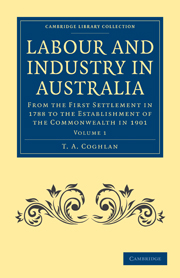 Labour and Industry in Australia
Labour and Industry in Australia Book contents
- Frontmatter
- PREFACE
- Contents
- PART I FROM THE FOUNDATION OF SETTLEMENT TO THE CROSSING OF THE MOUNTAINS
- I INTRODUCTION TO THE FIRST PERIOD
- II THE ASSIGNMENT SYSTEM
- III MUSTERS
- IV WAGES AND WORKING HOURS
- V THE CURRENCY
- VI LAND POLICY
- VII THE GENESIS OF THE WOOL INDUSTRY IN AUSTRALIA
- VIII THE INDUSTRIES OF THE PERIOD
- IX TRADE AND PRICES
- PART II FROM THE CROSSING OF THE MOUNTAINS TO THE ABOLITION OF THE ASSIGNMENT SYSTEM
- PART III FROM THE ABOLITION OF THE ASSIGNMENT SYSTEM TO THE DISCOVERY OF GOLD
- PART IV FROM THE DISCOVERY OF GOLD TO THE INTRODUCTION OF FREE SELECTION OF LAND BEFORE SURVEY
I - INTRODUCTION TO THE FIRST PERIOD
Published online by Cambridge University Press: 05 August 2011
- Frontmatter
- PREFACE
- Contents
- PART I FROM THE FOUNDATION OF SETTLEMENT TO THE CROSSING OF THE MOUNTAINS
- I INTRODUCTION TO THE FIRST PERIOD
- II THE ASSIGNMENT SYSTEM
- III MUSTERS
- IV WAGES AND WORKING HOURS
- V THE CURRENCY
- VI LAND POLICY
- VII THE GENESIS OF THE WOOL INDUSTRY IN AUSTRALIA
- VIII THE INDUSTRIES OF THE PERIOD
- IX TRADE AND PRICES
- PART II FROM THE CROSSING OF THE MOUNTAINS TO THE ABOLITION OF THE ASSIGNMENT SYSTEM
- PART III FROM THE ABOLITION OF THE ASSIGNMENT SYSTEM TO THE DISCOVERY OF GOLD
- PART IV FROM THE DISCOVERY OF GOLD TO THE INTRODUCTION OF FREE SELECTION OF LAND BEFORE SURVEY
Summary
The American colonies were long used as a receptacle for political prisoners and offenders against the laws of England. Even after the revolt of the thirteen States, convicts were transported to America, and transportation warrants still exist among the records of the Home Office, dated 1783 and 1784, and addressed to the Superintendent of the hulks in the River Thames, requiring him to deliver certain convicts under his charge to the Contractor, for the purpose of conveyance to North America. When, however, the independence of the Union was, by the provisions of the Peace of Versailles, recognized by England, the overcrowded condition of the gaols compelled the authorities to deport elsewhere the criminals, who were fast becoming a danger and an embarrassment. The coasts of Africa were first tried and many convicts sent thither. The unhealthiness of the climate was, however, so great and the mortality so appalling, that transportation to Africa was given up in the year 1785, and a new depot was looked for. Hence the first proposals of a definite character for the colonization of Australia arose from the necessity of finding a suitable place for the reception of British criminals. Concurrently with these proposals other ideas were at work.
- Type
- Chapter
- Information
- Labour and Industry in AustraliaFrom the First Settlement in 1788 to the Establishment of the Commonwealth in 1901, pp. 3 - 23Publisher: Cambridge University PressPrint publication year: 2011First published in: 1918


